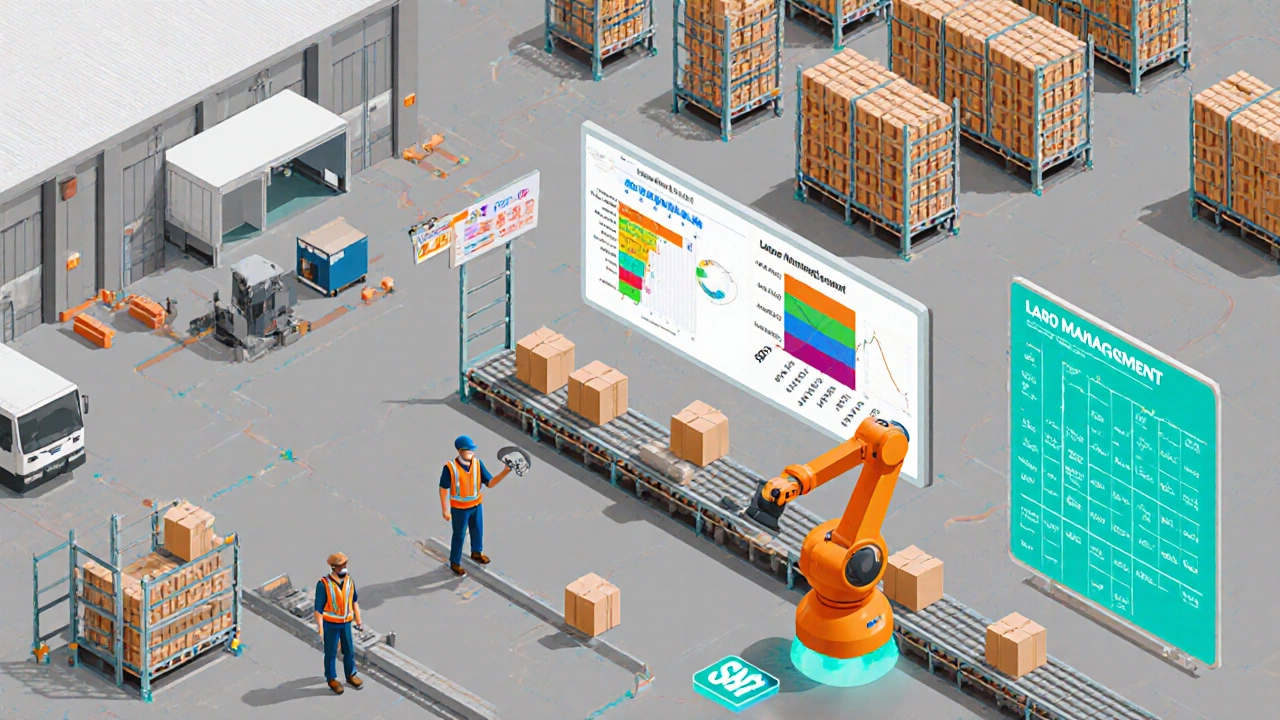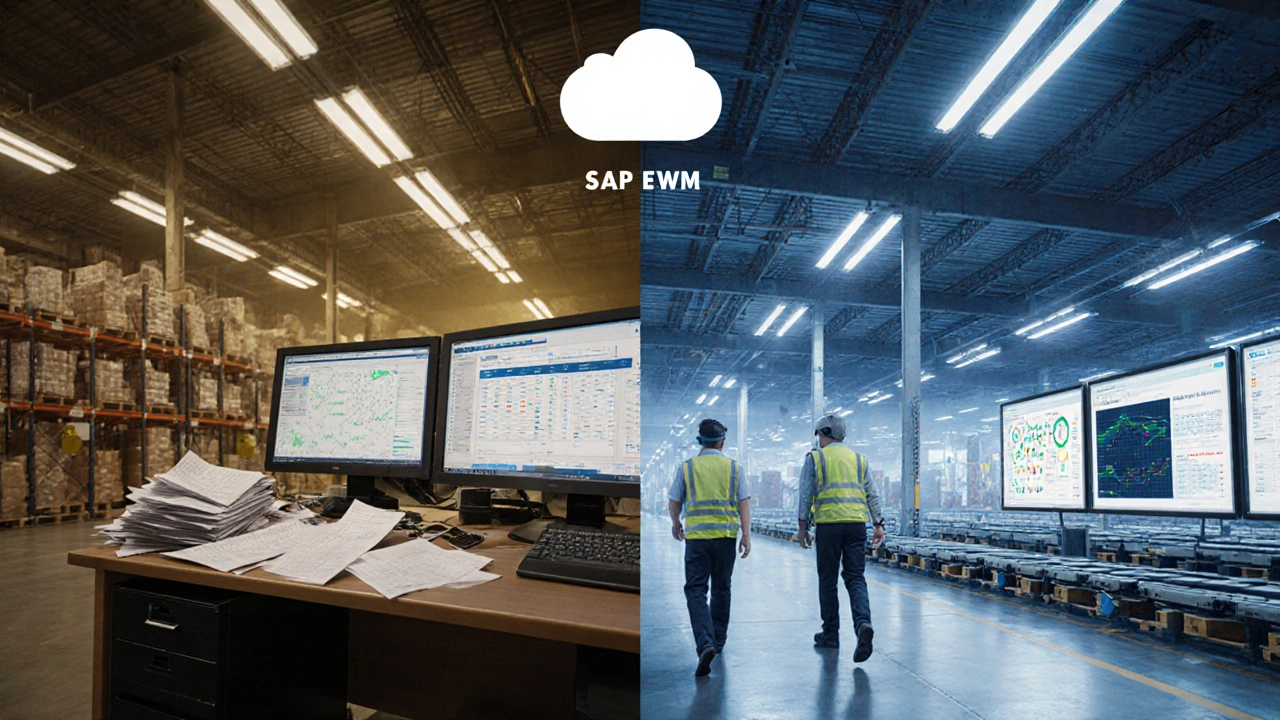SAP EWM vs Traditional WMS Comparison Tool
Compare Your Warehouse Needs
Select the features most important to your warehouse operation. This tool will show how SAP EWM and traditional WMS systems compare based on your selections.
Key Features
Results
SAP EWM Score
Traditional WMS Score
Quick Summary / Key Takeaways
- SAP is an ERP platform that offers specialised modules for warehouse operations.
- SAP EWM (Extended Warehouse Management) extends core ERP to handle complex logistics.
- Key benefits include real‑time inventory visibility, reduced picking errors, and scalable automation.
- A successful rollout follows a clear checklist: assess needs, map processes, configure, test, train, and go live.
- Compare SAP EWM with traditional WMS to decide if the investment matches your growth plans.
When people hear "SAP" they often think of big‑business finance software. In reality, SAP powers the brain of many modern warehouses, connecting everything from inbound trucks to the handheld scanner in a picker’s hand. Below we break down exactly what SAP does inside a warehouse, why it matters, and how you can get it up and running.
What is SAP?
SAP is a multinational software company that created an integrated suite of enterprise‑resource‑planning (ERP) applications. The flagship product, SAP S/4HANA, runs on an in‑memory database and provides real‑time data across finance, procurement, manufacturing, and logistics. While the ERP core handles order‑to‑cash and procure‑to‑pay, the warehouse‑specific extensions turn raw data into actionable tasks on the shop‑floor.
How SAP Fits into Warehouse Operations
Within a warehouse, SAP’s role is most visible through two dedicated modules:
- SAP EWM (Extended Warehouse Management) is a specialised WMS built on top of the ERP core. It manages inbound, storage, picking, packing, and outbound processes with granular control.
- SAP S/4HANA (the next‑gen ERP) provides the data platform that feeds EWM, ensuring inventory balances and financial postings are always in sync.
Think of SAP S/4HANA as the nervous system and SAP EWM as the muscular system that actually moves goods. Together they deliver what most logistics leaders call a SAP warehouse solution.

Core Components of SAP Warehouse Management
Whether you run a small regional hub or a 1‑million‑square‑foot fulfillment center, the same logical building blocks appear:
- Inventory Management - tracks every SKU, batch, and serial number in real time. SAP uses the stock‑keeping unit (SKU) master data to assign storage bins and calculate availability.
- Order Fulfilment - receives sales orders from ERP, creates warehouse tasks (put‑away, pick, transfer), and confirms shipments back to finance.
- Labor Management - records employee time, assigns work queues, and measures productivity per hour.
- Yard Management - coordinates dock doors, trailer locations, and gate‑in/out events, reducing dock congestion.
- Automation Interfaces - connects to conveyor belts, sortation systems, and robots via standard APIs.
Each component can be turned on or off, allowing you to start simple and add complexity as you grow.
Why Use SAP in a Warehouse?
Real‑world results help illustrate the upside:
- A European consumer‑goods distributor reported a 22% reduction in order‑to‑ship time after migrating from a legacy WMS to SAP EWM, thanks to dynamic slotting and automated wave planning.
- Inventory accuracy climbed from 92% to 99.5% within six months because every movement is posted instantly to the ERP ledger.
- Labor costs fell 15% when pick‑by‑voice and RF‑based work queues replaced paper pick lists, giving supervisors live visibility into operator performance.
- Regulatory compliance improved; SAP automatically records batch traceability for pharmaceuticals, satisfying EU GMP requirements without extra spreadsheets.
Beyond numbers, the strategic advantage is clear: a unified data model eliminates the “two‑system headache” where the WMS lives in a silo and the ERP has stale inventory figures.
Step‑by‑Step Checklist for a Successful SAP Warehouse Rollout
Getting SAP EWM live is a project, not a quick install. Follow this practical roadmap:
- Assess Business Requirements
- Map current inbound/outbound flows.
- Identify pain points - e.g., high dock wait times or inaccurate counts.
- Define KPIs (order‑cycle time, pick accuracy, inventory variance).
- Choose the Right SAP Edition
- On‑premise S/4HANA with EWM embedded (ideal for large enterprises).
- Cloud‑based SAP S/4HANA with EWM as a separate tenant (flexible scaling).
- Design Warehouse Master Data
- Set up SKU master records, storage type hierarchy, and bin locations.
- Configure RFID or barcode standards for data capture.
- Configure Process Flows
- Define inbound receipt strategies (full, partial, cross‑docking).
- Set up pick strategies - zone, wave, or pick‑by‑voice.
- Map outbound delivery creation and shipping label generation.
- Integrate Hardware
- Deploy handheld barcode scanners or RFID readers.
- Connect to conveyor control systems via standard SAP APIs.
- Test End‑to‑End Scenarios
- Run a pilot with a single product line.
- Validate inventory updates, financial postings, and exception handling.
- Train Users
- Provide role‑based training - warehouse operators, supervisors, and IT admins.
- Create quick‑reference guides for common screens (e.g., Warehouse Monitor).
- Go Live & Monitor
- Switch over during a low‑volume window.
- Track KPIs for the first 30days, adjust tunings as needed.
Following this checklist reduces risk and helps you see ROI faster.

SAP EWM vs. Traditional Warehouse Management Systems
| Feature | SAP EWM | Legacy WMS |
|---|---|---|
| Real‑time Inventory Updates | Instant, synced with ERP | Batch updates, delay up to 30min |
| Scalability | Cloud‑native, unlimited users | Server‑based, limited licensing |
| Integration with Finance | Seamless GL posting per movement | Manual interfaces, reconciliation needed |
| Advanced Slotting & Wave Planning | AI‑driven, dynamic re‑slotting | Static rules, manual overrides |
| Compliance & Traceability | Built‑in batch, serial, and EPC tracking | Add‑on modules, often incomplete |
| Total Cost of Ownership (5yr) | Higher upfront, lower ongoing ops cost | Lower license, higher maintenance & integration cost |
If your business needs deep integration with finance, global compliance, or plans for rapid growth, SAP EWM usually wins the long‑term battle.
Common Pitfalls & Pro Tips
Even seasoned implementers stumble. Here’s what to watch out for and how to avoid it:
- Pitfall: Over‑customising the data model early on.
Tip: Start with SAP’s standard master data fields; only add extensions after you’ve proven a business need. - Pitfall: Ignoring change‑management for floor staff.
Tip: Run hands‑on workshops with actual pickers before go‑live; their feedback often reveals hidden process gaps. - Pitfall: Treating EWM as a “set‑and‑forget” system.
Tip: Schedule quarterly reviews of slotting algorithms and labor reports - the warehouse environment evolves fast. - Pitfall: Not aligning yard management with dock scheduling software.
Tip: Enable SAP’s Yard Management module or integrate via API to avoid trailer bottlenecks.
Next Steps & Troubleshooting
If you’re ready to explore SAP for your warehouse, start with a small pilot:
- Contact a certified SAP partner for a discovery session.
- Select one product line and map its end‑to‑end flow.
- Run a 4‑week trial using SAP’s cloud sandbox; measure the same KPIs from the checklist.
Should you encounter issues, use this quick‑fix guide:
- Data mismatches - run the SAP “Stock Reconciliation” report and correct master data.
- RFID read failures - verify antenna power, update firmware, and check SAP’s Device Configuration table.
- Performance lags - enable HANA’s in‑memory compression and review background job scheduling.
Frequently Asked Questions
What is the difference between SAP WM and SAP EWM?
SAP WM (Warehouse Management) is the older module that runs inside the classic SAP ERP suite. It handles basic inbound/outbound processes but lacks advanced slotting, labor management, and native integration with S/4HANA. SAP EWM is a newer, standalone application that offers richer functionality, scalability, and a modern UI, making it suitable for complex, high‑volume distribution centers.
Can I run SAP EWM on the cloud?
Yes. SAP offers EWM as a cloud service on SAP Business Technology Platform. The cloud version provides automatic updates, elastic scaling, and lower infrastructure overhead compared to on‑premise deployments.
Do I need RFID tags to use SAP EWM?
No. SAP EWM supports both barcode and RFID. Choose the technology that fits your budget and accuracy needs. RFID offers line‑of‑sight‑free reads, while barcodes are cheaper and easier to implement.
How does SAP EWM improve order‑to‑ship time?
EWM creates dynamic pick waves based on real‑time order priority, inventory location, and labor availability. This reduces travel distance for pickers and allows the system to batch similar items together, cutting the average order‑to‑ship cycle by up to 25% in many case studies.
What hardware is required for a basic SAP warehouse?
At a minimum you need handheld barcode scanners or RF devices, a Wi‑Fi network covering the warehouse, and a dedicated PC or tablet for supervisory dashboards. Optional upgrades include RFID readers, voice‑directed picking headsets, and conveyor system integrations.





